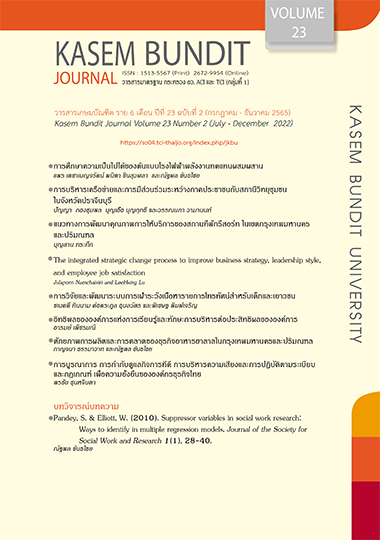Pandey, S. & Elliott, W. (2010). Suppressor variables in social work research: Ways to identify in multiple regression models. Journal of the Society for Social Work and Research 1(1), 28-40.
Keywords:
ตัวแปรกด, การวิเคราะห์การถดถอยเชิงพหุ, ตัวแปรกดคลาสสิกAbstract
วัตถุประสงค์ เพื่อนำเสนอ ให้คำจำกัดความ จำแนกประเภทและวิเคราะห์ตัวแปรกดในการวิเคราะห์การถดถอยเชิงพหุ วิธีการ การวิจัยจากเอกสารที่เกี่ยวข้อง ผลการวิจัย ตัวแปรกด เป็นตัวแปรซึ่งมักถูกมองข้ามความสำคัญในการวิเคราะห์การถดถอยเชิงพหุ เป็นตัวแปรซึ่งมีสหสัมพันธ์กับตัวแปรพยากรณ์แต่ไม่มีสหสัมพันธ์กับตัวแปรผลลัพธ์ จำแนกเป็น 4 ประเภท คือ ตัวแปรกดคลาสสิก ตัวแปรกดนิเสธ ตัวแปรกดซึ่งมีสหสัมพันธ์ทางลบกับตัวพยากรณ์ และตัวแปรกดสมบูรณ์และเชิงสัมพัทธ์ วิธีการวิเคราะห์ตัวแปรกดสามารถทำได้โดยวิธีการวิเคราะห์สหสัมพันธ์อย่างง่ายและการวิเคราะห์การถดถอย นัยทางทฤษฎี/นโยบาย นักวิจัยทางสังคมศาสตร์ควรทำการวิเคราะห์ตัวแปรกดในการวิเคราะห์การถดถอยเชิงพหุ เพราะทำให้เข้าใจและแปลความหมายผลการวิเคราะห์การถดถอยได้ถูกต้องยิ่งขึ้น
References
Buripakdi, C. & Khanthachai, N. (1977). The value of children: Thailand. East-west Population Institute, East-west Center, Honolulu and the Institute of Population Studies, Chulalongkorn University, Bangkok.
Hayes, A. F. (2018). Introduction to mediation, moderation and conditional process analysis: A regression-based approach. The Guilford Press.
Hoyle, R. H. (Ed.). (1995). Structural equation modeling: Concepts, issues, and applications. Sage Publications.
Pandey, S. & Elliott, W. (2010). Suppressor variables in social work research: Ways to identify in multiple regression models. Journal of the Society for Social Work and Research 1(1), 28-40.
Downloads
Published
How to Cite
Issue
Section
License
Copyright (c) 2022 KASEM BUNDIT JOURNAL

This work is licensed under a Creative Commons Attribution-NonCommercial-NoDerivatives 4.0 International License.
ทัศนคติ ความคิดเห็นใด ๆ ที่ปรากฏในวารสารเกษมบัณฑิตฉบับนี้เป็นของผู้เขียน โดยเฉพาะ มหาวิทยาลัยเกษมบัณฑิตและบรรณาธิการ ไม่จำเป็นต้องมีความเห็นพ้องด้วย







